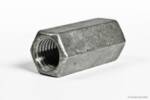Newest FAQs
A common question that we encounter has to do with what type of coupling nut should be used in conjunction with a particular grade of bolt or rod. Typically, a coupling nut would be specified as a grade of nut, as opposed to a grade of bolt. The ASTM grade of hex nut that is... Read more

There are several different thread series available for construction fasteners. Below are the three of the most common thread series utilized in the fastener industry. Coarse Thread Series Unified National Coarse (UNC) – Coarse threads have fewer threads per axial distance than fine threads and a larger thread form relative to the diameter. Coarse thread... Read more
Yes. At Portland Bolt we are frequently asked this question. In order to better understand the answer, some background information on these two specifications is necessary. Both the A325 and the A490 specifications cover high strength, heavy hex, structural bolts from ½” diameter through 1½” in diameter. Both ASTM A325 and A490 specify shorter thread... Read more
Truly an asset you may not always like paying for but one you surely cannot live without. All manufacturers, wholesalers, distributors, in fact all those involved in the “stream of commerce” should have adequate product liability insurance. Product liability insurance is an insurance policy that would provide protection against liabilities, within the policy limits, for... Read more
Since the new chemicals (alkaline copper quat [ACQ], copper azole [CBA-A and CA-B], and sodium borates [SBX]) now being used in pressure treated wood have been shown to be up to two or three times more corrosive than the previously used chromate copper arsenate (CCA), the recommended galvanizing thickness for materials being used with the... Read more
No. The products manufactured by Portland Bolt do not fall under the umbrella of products that would require a UL listing or ICC-ES report. There are three main governing bodies that cover specifications for fasteners. ASTM (American Society for Testing and Materials) covers primarily bolts and fasteners for construction applications. SAE (Society of Automotive Engineers)... Read more
Altering a bolt’s length or configuration in the field is acceptable as long as it does not change the length originally specified by the designer or engineer. If a bolt is longer than what was originally needed, the bolt can be cut down in the field. How the bolt is cut is important to consider.... Read more
While these two bolts are virtually identical in terms of chemical and physical strengths and properties, there are several differences between the two. The Grade 5 specification falls under the Society of Automotive Engineers (SAE) classification system, while A325 is an ASTM specification. ASTM A325 bolts are more commonly specified by engineers for use in... Read more
To answer this question, you first need to know some basic information about stainless steel. “Stainless Steel” is the general name for a large family of alloy steels that contain at least 10.5% chromium as part of their composition. At and above this level of chromium, a complex chrome-oxide surface layer forms that prevents further... Read more
A bolt that has already been used in a given application may or may not be reused, depending on the grade, application, and recommendation of the “Engineer of Record”. There are a tremendous number of conflicting opinions on this subject, but the only definitive published information we can find on this issue from a reputable... Read more
